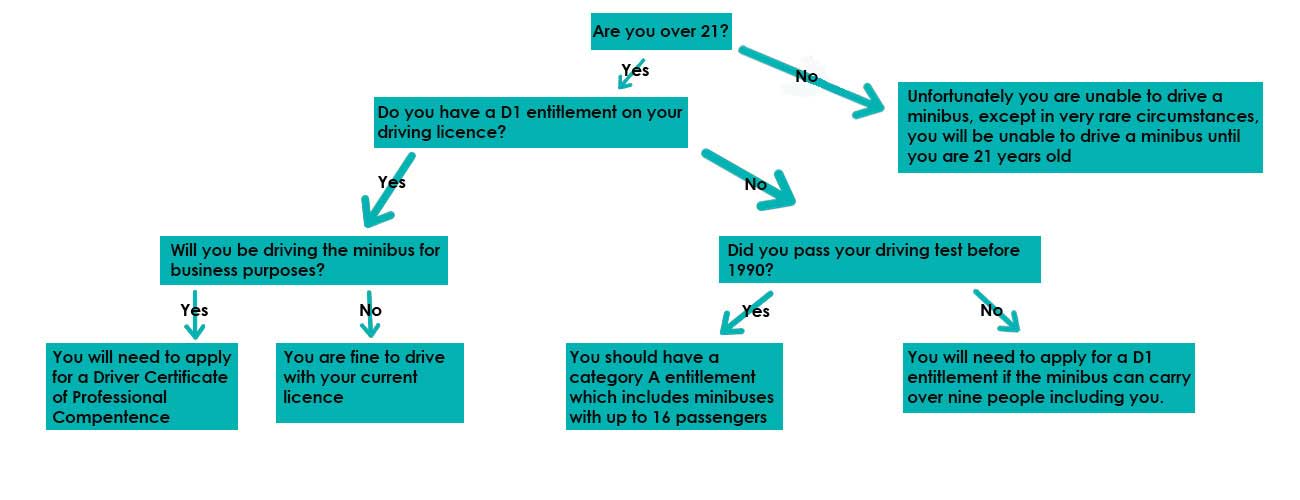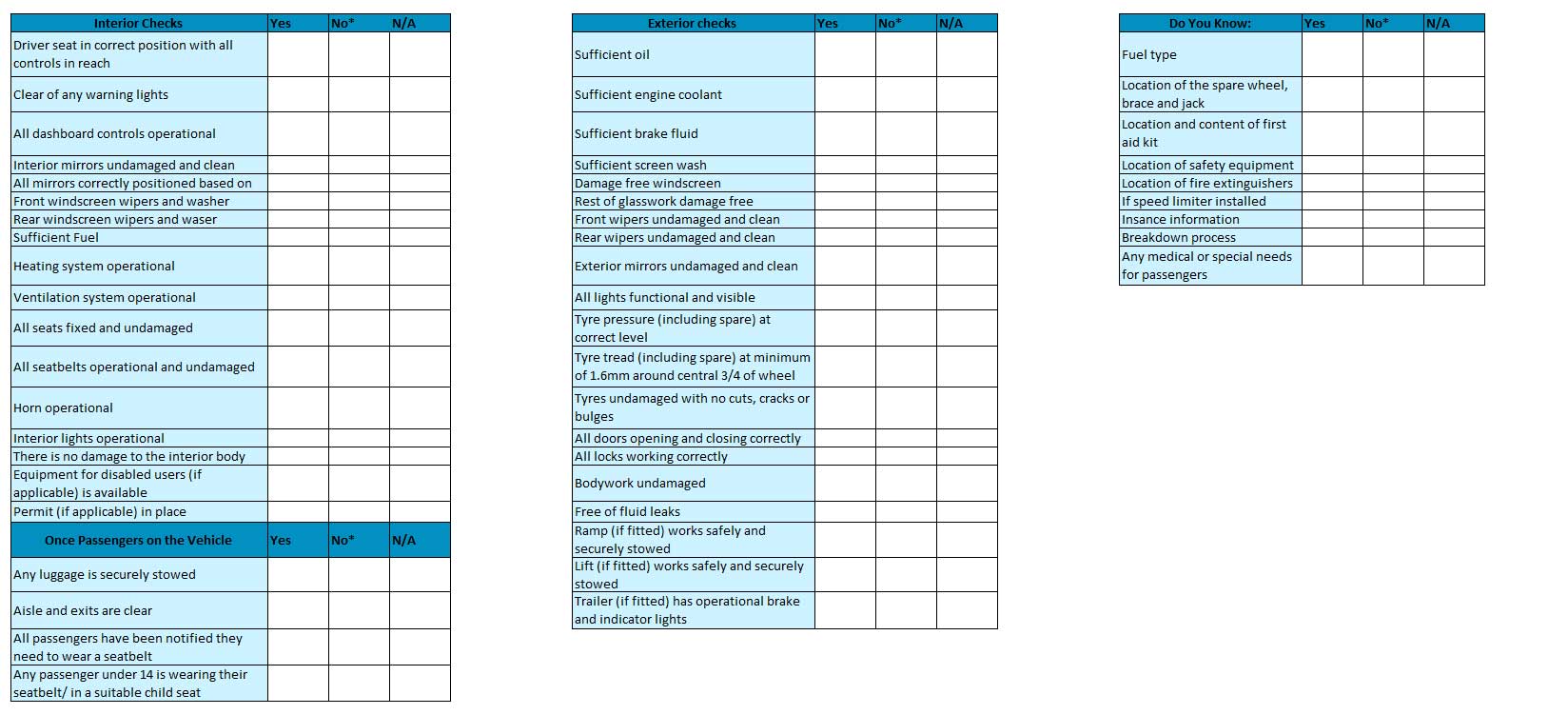This guide is designed to help drivers understand who can drive a minibus, including any additional qualifications or permits they need, how you need to adapt your driving style to the larger vehicle and all the essential info you should know before driving one.
Who Can Drive a Minibus?
This can be a complicated question to answer as it depends on when you passed your driving test, how many seats the vehicle has, and what you are using in the minibus for.
All drivers with a full UK driving licence will be able to drive a minibus that has up to eight passenger seats, in addition to the drivers seat, under their category B1 entitlement. However, to drive a minibus with more seats they will need to have an additional entitlement. What is needed will depend on the number of seats required, with up to 16 seats needing a D1 and over that needs a Passenger Carrying Vehicle (PCV) qualification. Additionally, if the vehicle has a gross vehicle weight of over 7.5 tonnes then you will need a further qualification.
Drivers who passed their driving test and received their full UK driving licence between 1990 and 1997 will automatically receive the D1 entitlement on their driving licence so can drive a vehicle with up to 16 seats without needing to apply for an additional licence. If 101 appears next to their D1 entitlement drivers will not be able to drive a minibus for hire or reward.
Drivers who passed before 1990 will also have an automatic entitlement, but because of the way vehicles were categorised before then this will be covered by the category A entitlement on their licence. For drivers older than 70 years old they will need to be able to meet the standards for driving a D1 in order to drive a minibus.
Drivers who obtained their licence after 1997 will not automatically be able to drive a vehicle with more than nine seats (including the driver) and so if they want to drive a larger minibus they will need to apply for a D1 or PCV qualification depending on the size of the vehicle.
It’s important to note that any driver who wants to drive a minibus will need to be over 21 years old. There are a few rare circumstances that someone under the age of 21 who has passed their PCV test will be able to drive a minibus but these will not be common.
When Can Someone Under 21 Years Old Drive a Minibus?
If they have passed their PCV test and:
- Are driving a passenger vehicle out of service without passengers. For example, driving a rental vehicle to deliver / collect it from a client.
- Driving on a regular service where the speed limit does not exceed 50 km (approx. 30 mph).
- Driving a passenger vehicle that can carry no more than 16 passengers under a PSV operator licence or Section 19 or 22 permits.
There are rare circumstances when you may be able to drive a minibus without a D1 or A entitlement, and they will usually only occur when you are a volunteer driver in the UK and are not the main driver of the vehicle.
To be able to drive a 17 seater, or smaller minibus, without the D1 or A entitlement the bellow requirements need to be met:
- They are aged 21 or older
- They have held a category B (car) licence for at least two years
- The vehicle is used for social purposes by a non-commercial body (not a business including charities and schools)
- The maximum gross weight of the vehicle does not exceed 3.5 tonnes, or 4.25 tonnes if it includes specialist equipment for disabled passengers
All of these conditions will need to be met in order to be able to drive without an entitlement on your licence.
Driving a Minibus Commercially (For Your Company)
If you are required to drive a minibus as part of your job, even if it is not for hire and reward, then you will need a Driver Certificate of Professional Competence (CPC).
In order to obtain a CPC you will need to have 35 hours of training over a period of time and this will need to be repeated every five years in order to keep a valid certificate after that time.
Can I Drive a Minibus?

Please note that if you intend to drive the vehicle for hire and reward you will need to apply for additional permits. If your business provides transport on a not-for-profit basis then you will need to apply for permits under Section 19 or Section 22 of the Transport Act 1985. These permits allow you to accept payment without needing to apply for a full PSV licence but are only available if you meet a certain criteria and are linked to the business so can move between vehicles as needed.
If you are charging for the use of the vehicle and do not meet these criteria then you will need to apply for a PSV licence.
Can I Drive a Minibus for My Business?
If you are required to drive a minibus for your company as part of your role within the business you will need to get a CPC which requires you to do at least 35 hours of training over a period of time, to ensure you feel comfortable and are competent behind the wheel.
You should not get behind the wheel until you have your CPC, and the business has the relevant permits (see below) if needed.
Section 19 permits are available for educational and other bodies that are using a minibus.
They will either be a standard permit, for vehicles that carry no more than 16 passengers, or large bus permits, for those that carry 17 or more passengers.
These permits will be granted to organisations that operate the vehicle without the intention of profiting from their passengers.
This permit does not allow you to carry members of the general public.
A section 22 permit is issued to bodies who are concerned for the social and welfare needs of one or more communities so use the bus to provide a community bus service they can utilise.
Unlike the section 19 permits a section 22 permit allows you to carry members of the general public as they provide local bus services, which is defined as services using public service vehicles for the carriage of passengers by road at separate fares on which passengers may travel for less than 15 miles.
For any vehicle that can carry more than eight passengers and is available for hire or reward, including those provided by local and public authorities, statutory undertakings and any commercial activity.
Privately run minibuses, where payment is not made by the passengers, will not be covered and you may want to contact your local authority’s PSV department for further information.
There are four types of PSV licences:
- A standard licence – for national and international operations
- A standard licence – for national (GB) operations only
- A restricted licence – for small operations, not in passenger transport business
- A special licence – for taxi licence holders
When applying for a PSV licence a number of criteria will need to be met and you can find more details of these here.
Minibus Condition
Being prepared to drive a minibus is not just making sure that you are qualified to drive it but also that the minibus is in a safe and roadworthy condition for you to drive.
We’ve got a pre-driving check a little further down but in general you want to make sure:
- The vehicle has a valid MOT
- The vehicle is up to date with its servicing
- There are no obvious signs of damage or excessive wear, including tyres and glasswork damage
- There are no active warning lights on the dashboard
There are also a few things you should be aware of specific to minibus’ that we’ve highlighted in the next few sections.
Seatbelts
Minibuses that are first registered from November 2001 onwards are required by law to have three-point seatbelts on all seats. This is the same type of seatbelt that you will find in any car.
Buses registered in October 2001 and earlier were not required to have a three-point seatbelt in passenger seats unless they were being used to carry children.
Just like it would be as the driver of any car when you’re driving a minibus it is your responsibility to ensure that:
- All children under the age of three are in an appropriate car seat where available
- All children aged between three and 11 years old or 135 cm tall use an appropriate restraint or seatbelt
- Anyone under the age of 14 wears a seatbelt where available
- You are wearing an appropriate seatbelt
You will also be required to notify other passengers of their need to use a seatbelt whilst the vehicle is moving.
Safety Equipment
Minibuses are required to carry suitable apparatus for extinguishing a fire if one occurs on the vehicle. These must be accessible, maintained in good working order, and comply with British Standards Institution BS 5423: 1977, BS 5423: 1980, or BS 5423: 1987 and have a minimum test fire rating of 8A or 21B and contains water or foam not a dry powder.
It’s a legal requirement for your company to test the extinguisher to the manufacturer’s schedule (usually annually) and ensure that if it is used it is promptly replaced before any further journeys are taken in the vehicle.
Training to Drive a Minibus
Whether you have a D1 or A entitlement on your licence if you are driving a minibus as part of your job then you will need to a Certificate of Professional Competence (CPC) as explained above. This requires you to undergo 35 hours of training over a period of time in order to get the certificate, and then repeat the training every five years in order to retain the certificate.
You might also be offered or request additional training from your employers if it has been a while since you’ve driven one or it’s your first time and you want additional support.
Driver Hours
If driving a minibus is the primary purpose of your job then you will need to obey the laws on time spent behind the wheel.
If your vehicle carries eight or fewer passengers then you will not have restrictions on the hours you can drive but if it carries more than this there will be restrictions you need to obey.
The government has a detailed breakdown on what the limits for hours are and when they apply here which we recommend you review this to check which regulations will apply to you.
Before Agreeing to Drive a Minibus
Before agreeing to drive a minibus you should:
- Check you’re entitled to drive the vehicle
- Make sure you’re insured to drive the minibus
- Check it is in a roadworthy condition, has a valid MOT and is taxed
- If a permit is needed then check this is available in the vehicle
Once you’ve checked these details you should ask yourself if you feel confident and comfortable getting behind the wheel and ask for any additional training you think is required. It’s important that when you’re behind the wheel of any vehicle you are in complete control of it and you should not be afraid to tell your employer that you need more training in order to do so.
General Minibus Driving Tips
We know that driving a minibus can be daunting, especially if it’s your first time so we’ve gathered these driving tips to help you.
Pre-Travel:
- Plan your route, especially if you’re going to need driving breaks or your passengers will need regular comfort breaks.
- Make sure you’re fit to drive; you’re well rested, have glasses on if needed, are not under the influence of anything including prescription medication.
- Complete a pre-travel inspection of the vehicle.
- Make sure the bus is not overloaded with too many passengers or luggage.
- Have a list of all passengers and any medical conditions or special needs in case the vehicle is involved in an accident.
- If you have any passengers in a wheelchair they are safely restrained if sitting in the chair, and sitting in one of the vehicle’s seats then their wheelchair is securely stowed.
- If any passengers are carrying an oxygen cylinder then display appropriate signs to advise first responders in the event of an accident or fire.
- Make sure that you have notified passengers that they all need to wear a seatbelt, and that you have checked all children under 14 are wearing one (this is your responsibility as the driver).
- Set the route on your satnav before setting off, and do not use this or any other mobile device while the vehicle is operational.
During Travel:
- Stay alert and take regular comfort breaks so that you can keep yourself fed and hydrate, use the facilities and rest where needed.
- Keep to the advised speed limits. Please note that a minibus that is longer than 12 metres it can only travel at 60 mph, even on the motorway. If the vehicle was first used from October 2005 then it will have a speed limiter installed which restricts you to 62 mph.
- Leave a larger gap between you and the vehicle in front than you would with a car, a minibus will be heavier and so have a longer braking distance if a hazard arises.
- Watch out for poor weather and where necessary travel at lower speeds to give yourself more reaction time should a hazard arise.
- Advise your passengers on appropriate behaviour and do not allow disruptive behaviour that could distract you from the road.
- If you leave the vehicle turn the engine off and don’t leave any children on the vehicle unattended.
- If you are involved in an incident then make sure you give clear concise instructions to your passengers.
- If there is any risk of fire, no matter how small, evacuate the vehicle.
After Travel:
- Park so that anyone exiting the vehicle steps onto a footpath and not out into the road.
- Do not allow anyone to exit the vehicle until vehicle is at a complete standstill, with the handbrake engaged in a safe location.
- Safely operate the lift / ramp when needed, ensuring no other passengers are in the way before doing so.
- Conduct a post trip inspection and note any damage that may have occurred during the journey.
Pre-Driving Minibus Checklist

* If you answered no to any of these please make sure that this does not hinder you from driving the minibus safely and in adherence to your company’s policy and any necessary work is completed as soon as possible.
We’ve also got a downloadable copy here if you would like one to have to hand.
Your Minibus Questions Answered
Who Can't Drive a Minibus?
You must meet the criteria set out above in order to qualify for driving a minibus so if you are under 21, or do not have a D1 or category A entitlement on your driving licence then you will not be able to drive a minibus.
What is a PSV Operator Licence?
A PSV licence is a licence that allows you to drive a vehicle, which can carry over eight passengers, and charge for hire and reward. So, to be paid for providing a transportation service.
What is the Maximum Speed Limit for a Minibus?
The maximum speed for a minibus will depend on its length. All minibuses must obey local speed limits in built-up areas, and to 60 mph on a dual carriageway. But if the overall length of the bus is under 12 metres then it can reach 70 mph on the motorway.
What Does a Minibus Driving Test Include?
There is a theory and practical test that you will need to take in order to get a D1 entitlement. This involves completing a theory examination about the theory behind driving a minibus and be fairly similar to the car theory test. Then once you have this you can complete the 1 hour 30 minutes practical test, which includes an observed drive, and a few additional questions
Can I Drive a Minibus Abroad?
You will need to check the country you plan on driving in but for most you'll be able to drive a minibus abroad provided that you meet all the requirements in order to drive one in the UK.
You should check a few things before doing so:
- Firstly if you are driving for work are you able to drive commercially on a standard licence in the country of travel
- Will your insurance provider cover you for carrying that many people abroad, and if you need to make any adjustments to your policy
- The local driving laws and if you feel comfortable following them
If you would like to learn more about being a company driver then click here, or if you are interested in more tips on road safety head here, and if you want to browse all our guides then you can do so here.



